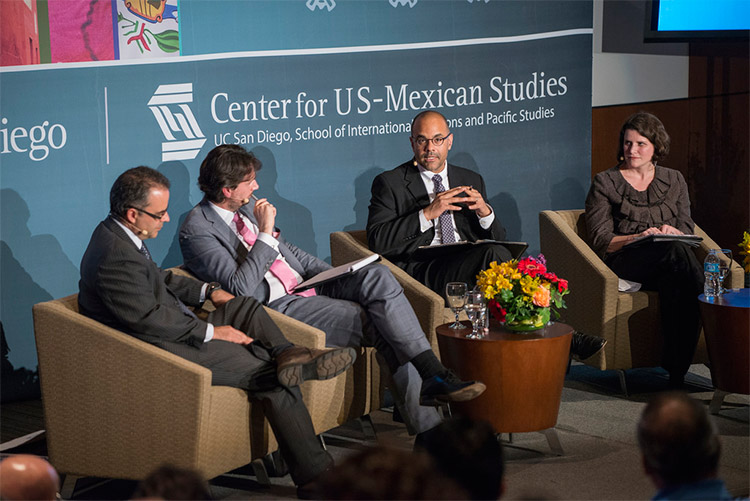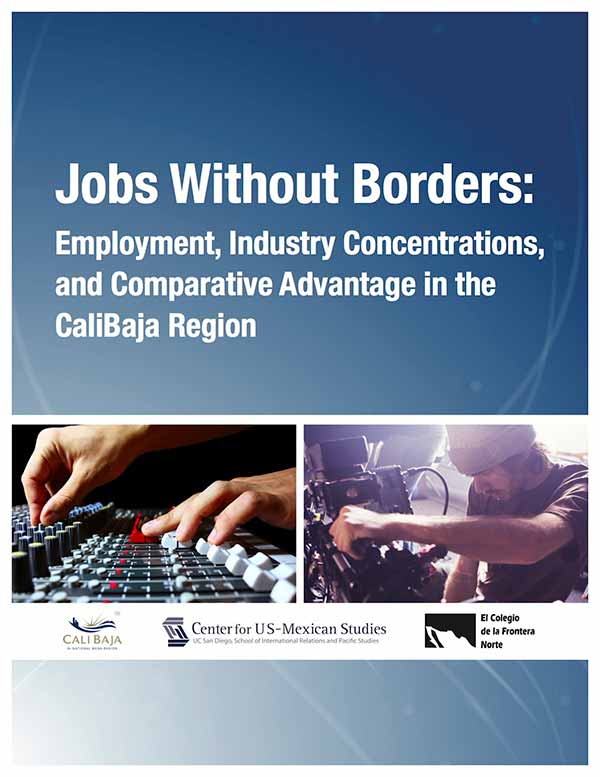
First-of-its-Kind Study Reveals San Diego and Imperial Counties and Baja California Region as Nexus
Report highlights area’s vital industry concentrations that have a competitive advantage in the global economy
Published Date
By:
- Christine Clark
Share This:
Article Content

UC San Diego visiting professor of international relations, David Shirk (center), moderating a panel discussion for the Mexico Moving Forward conference hosted by the Center for U.S.-Mexican Studies at the School of International Relations and Pacific Studies’ in March of 2014.
Results from a cross-border collaborative research effort studying employment and industries of the San Diego and Imperial counties as well as Baja California––which together make up the CaliBaja region––provides evidence of the region’s importance as a hub for manufacturing, with particular strengths in industry sectors like audio and video equipment manufacturing, and medical device and supplies manufacturing.
The research initiative is detailed in the recently released “Jobs without Borders: Employment, Industry Concentrations, and Comparative Advantage in the CaliBaja Region,” a report published by the Center for U.S.-Mexican Studies at the University of California, San Diego’s School of International Relations and Pacific Studies, the Colegio de la Frontera Norte and the Cali-Baja Mega-Region Initiative.
This report, conducted by a team of experts from both sides of the border, is the first of its kind to analyze industry-specific employment concentrations within the cross-border region as a whole. It is designed to identify further opportunities for economic integration between San Diego, Tijuana and surrounding communities.
“We are proud UC San Diego is part of this study, which offers new insights into the economy of our binational community,” said UC San Diego Chancellor Pradeep K. Khosla. “UC San Diego has a long history of partnership with Mexico, especially through our Center for U.S.-Mexican Studies. Together, we are working to strengthen our collaborations and improve the lives of citizens in both countries.”
In addition to finding that the CaliBaja region has mutually reinforcing strengths in high-tech industries, the “Jobs without Borders” report also highlights trade data that illustrates how CaliBaja is a vital connecting point for complementary industries in the Pacific region. The economic integration of the binational region facilitates competitiveness and innovation on both sides of the border, and makes CaliBaja an important point for production in North America, especially in such sectors as audio-visual manufacturing and several other key sectors.
“Thanks to the work of this cross-border research effort among key U.S. and Mexican stakeholders, this study will help to inform policy and industry decisions about investment in public infrastructure and workforce development,” said School of International Relations and Pacific Studies Dean Peter Cowhey. “The results reveal how the strong policy, commercial and industrial ties can continue to grow and how CaliBaja has many industries with a high-export capacity.”
Home to more than 6.5 million residents—nearly half the population of the border region—CaliBaja combines the most dynamic border economies of both the U.S. and Mexico. It has a gross regional product of more than $200 billion and accounts for over 70,000 northbound commercial and vehicular border crossings every day.
The “Jobs without Borders” report calculated the total employment by industry for the combined economies of CaliBaja as a single region, and then compared the binational region’s employment concentrations to the larger U.S. and Mexican economies. These measurements help identify industries that are the most concentrated as well as those industries that are most export oriented.
“Understanding the industry concentrations and comparative advantages of our regional economy is of central importance to ensuring long-term, sustainable economic growth,” said David Shirk, visiting professor of international relations at UC San Diego and a contributing author to the report. “As the United States and Mexico work to expand cross-border trade flows—now valued at over $500 billion—this study is designed to enhance competitiveness by providing unique insights into the core strengths of the binational economy along the U.S.-Mexico border.”
By analyzing the most recent local, industry-specific employment data from 1990 to 2008 collected from the U.S. Department of Labor, Mexico’s National Institute for Statistics and Geography (INEGI) and Statistics Canada, the “Jobs without Borders” study help illustrate the strengths and diversity of the binational region’s sub-economies: the combination of high-tech research and development capability in San Diego, agricultural production in Imperial Valley, and manufacturing in Baja California.
The study identified 41 highly concentrated industries in CaliBaja that have strong capacity for export-oriented manufacturing, including audio and video equipment manufacturing, medical equipment and supplies manufacturing, hardware manufacturing, communications equipment manufacturing, and semi-conductor and electronic component manufacturing. In addition, it found that Baja California’s labor force is key to the strong manufacturing orientation of the region as a whole, since 58 percent of the region’s labor supply in highly concentrated industries came from Baja California. In the region’s top 10 industries’ employment concentration in 2008, Baja California supplied 74 percent of the labor force while San Diego and Imperial counties supplied 26 percent.
“San Diego County, Imperial County and Baja California are better together,” said Shirk. “For example, the combined economy of the CaliBaja region accounted for nearly 40 percent of all employment in the audio and video equipment manufacturing sector in North America in 2008.”

On average, the region employed 28.8 times more people—31,609 employees—in this industry compared to any other place in the U.S. or Mexico.
“Looking at these two economies as one regional economy amplifies the importance of this sector within the CaliBaja region,” said Shirk.
Meanwhile, medical equipment and supplies have grown to become the region’s largest manufacturing sector. In 2008, the medical equipment and supplies manufacturing industry employed the largest number of people for a total of 43,015 in the CaliBaja region and the Baja California economy supplied 87 percent of the labor for this sector.
The “Jobs without Borders” report is a product of an ongoing collaborative research effort between the CaliBaja Mega-Region Initiative, the Center for U.S.-Mexican Studies and the Colegio de la Frontera Norte. Support for the initiative also comes from the U.S. and Mexican consulates of Tijuana and San Diego, as well as researchers from San Diego Association of Governments (SANDAG). The collaborative research initiative examines various economic and policy issues confronting CaliBaja, and is designed to strengthen economic ties between Tijuana and San Diego as well as to engage the unique economies of Imperial County and the rest of Baja California.
The Center for U.S.-Mexican Studies, based at UC San Diego’s School of International Relations and Pacific Studies, is a policy research institute. Since 1979, it has been a go-to source for extensive academic research on Mexico and U.S.-Mexico relations, informing the creation, implementation and evaluation of public policy.
To view the full “Jobs without Borders: Employment, Industry Concentrations, and Comparative Advantage in the CaliBaja Region” report, go here.
Share This:
You May Also Like
Stay in the Know
Keep up with all the latest from UC San Diego. Subscribe to the newsletter today.


